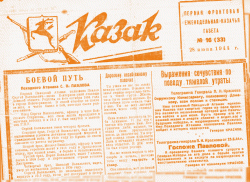Caught between two tyrannical 20th-century powers, Russian Cossacks of various
groups found themselves on opposite sides of World War II. CRL’s Slavic and
East European Microform Project recently coordinated the microfilming of a small
collection of Cossack newspapers published during the 1940s. (A few single issues were also digitized and are now available in the
- Kazachii vestnik (Der kosakenbote, Kozatskyi vystnik): informatsiia Kazach’ego natsional’nogo osvoboditel’nogo dvizheniia [Cossack National Liberation Movement] (Aug. 1941–Apr. 1945; Jun. 1951–Feb. 1958)
- Kazach’ia lava: tsentral’naia obshchekazach’ia gazeta (Apr. 16, 1944–Feb. 22, 1945)
- Kazachii’ klich: ezhenedel’naia gazeta 1-i Kazach’ei divizii (Dec. 1943–Oct. 1944)
- Kosakenruf (Apr. 1944) German issues of Kazachii klich
- Kazachii klinok (Mar. 1943–Feb. 1944)
- Kubanets (Jun.–Sep. 1943)
- Na kazach’em postu: dvukhnedel’nyi zhurnal dlia kazakov (Apr. 1943–Jan. 1945)
- Parizhskii Viestnik (Jan. 30–Feb. 27, 1943)
These newspapers record the pulse of various Cossack groups during this volatile time period. They breathe Cossack nationalism mixed with varying amounts of German military victories, Nazi propaganda, and anti-Bolshevik sentiment. Kazachii vestnik, for example, the organ of the Cossack National Liberation Movement (Kazach’e natsional’noe osvoboditel’noe dvizhenie) and probably the most blatantly nationalistic paper in the collection, chronicles many of the party’s public activities, meetings, resolutions, and other efforts to call their Cossack brothers to join the Nazis against a common enemy, the Bolsheviks.
While early issues bleed propaganda, as the tide of war turns against Germany in 1944–45, the “progress of the war” is replaced on the paper’s pages with an abundance of columns exhibiting a calmer Cossack sentiment. These include a bibliography of Cossack works, historical calendar, and a column dedicated to missing persons. Letters and testimonials of Bolshevik/Soviet atrocities committed against Cossacks also continue to appear regularly, but not as aggressively as in the early years of the war. After the war, Kazachii vestnik resumed publication in Munich in 1951. The focus on Cossack nationalism represents a new stage in the Cossacks’ fight for freedom and political identity. Published in the West, the paper has one column in English.
The newspapers as a whole add to the textual and visual chronicle of Cossack involvement in World War II on the German side. Kazachii klich is especially rich in photographs, artistic decoration, and cartoons. Many of these papers also feature Cossack verse and song lyrics.
These fascinating titles are sure to draw interest among Slavists and Germanists alike. Microfilm copies of these newspapers are held by the Center for Research Libraries and the University of Kansas.
New CRL Newspaper Acquisitions
CRL obtained a set of Xin Wen Bao microfilm from the National Library of China through the 2011 Shared Purchase Program. Originally operated jointly by foreigners and local Chinese and published in Shanghai, Xin Wen Bao was once the most widely distributed newspaper in China. The set covers the late Qing and the entire Minguo Republic eras, and will make the current CRL holdings of the newspaper’s back files complete.
The 2011 Shared Purchase Program also helped CRL to purchase the Lyttelton Times, one of the principal newspapers of New Zealand’s Canterbury region for 80 years. It was published from 1851 until 1929, when it became the Christchurch Times until publication ceased in 1935. CRL already holds LT from 1902 to 1906 and has a very limited representation of other New Zealand mainstream papers.
The South Asian Microform Project (SAMP) has extended its holdings of Ceylon Times by acquiring issues from 1924 to 1930. The original Ceylon Times was founded in 1846 and published until 1874. Restarted in 1882 by the publisher, the Times of Ceylon quickly regained its former prominence, read by British officials, planters, and merchants as well as the elite of Ceylon. It was a major vehicle for international, local, and business information for the nation of Ceylon (now Sri Lanka). CRL and SAMP continue to acquire reels to complete this collection, which currently spans 1863–74, 1901–30, 1941–54, and 1967–75. CRL obtained the 1941–54 reels through the 2008 Shared Purchase Program, with assistance from the University of Chicago and Columbia University. SAMP hopes to acquire Ceylon Times issues from the 1930s as funding permits.
The Cooperative African Materials Project (CAMP) microfilmed a set of Zimbabwean newspapers collected by the Library of Congress office in Nairobi, including The Worker, Zimbabwe Standard, Business Tribune, City Observer, and others. CAMP is also microfilming a set of newspapers from Cameroon and has finished 16 titles ranging from 1997 to 2007, including Ouest Echos (Sept. 1997–Dec. 2005).
